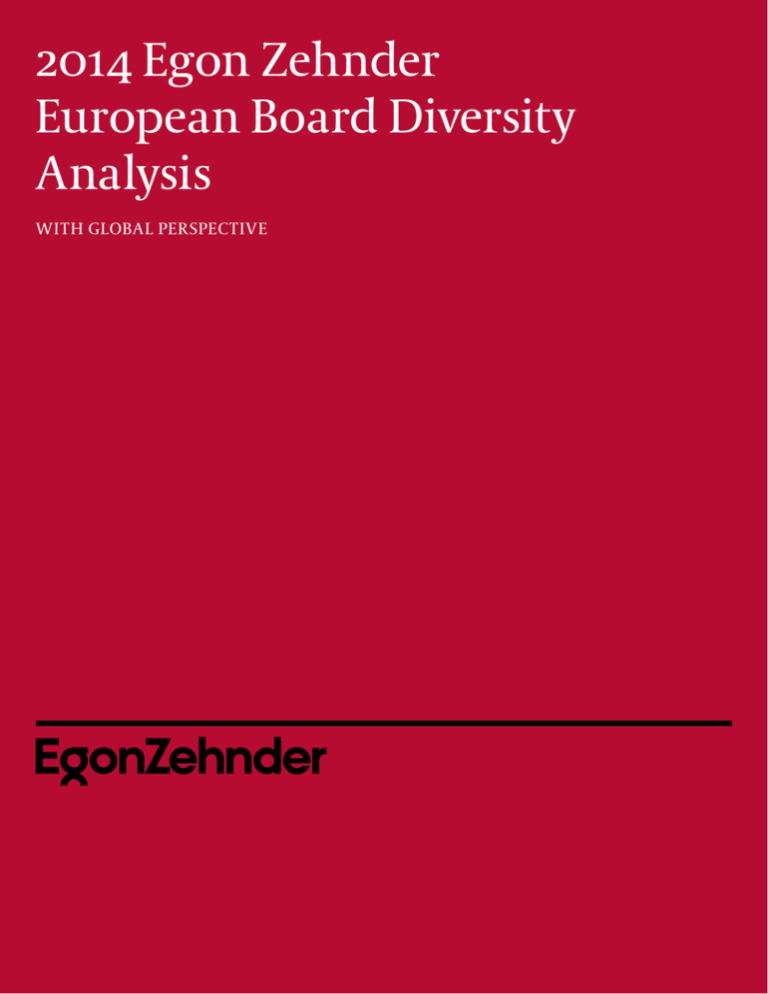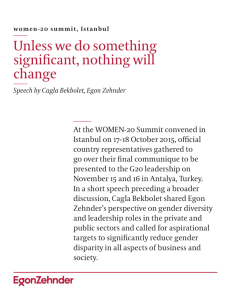
2014 Egon Zehnder
European Board Diversity
Analysis
With Global Perspective
Egon Zehnder 2014 EUROPEAN BOARD DIVERSITY ANALYSIS
contents
FOR EWOR D
3
THE ROA D TO BOA R D DIV ERSIT Y
4
SU MM A RY OF 201 4 F IN DINGS
8
ST U DY DESIGN
19
2
Egon Zehnder 2014 EUROPEAN BOARD DIVERSITY ANALYSIS
3
FOR EWOR D
We are pleased to share with you the findings
of our 2014 Egon Zehnder European Board Diversity
Analysis. Three conclusions from the 2014 study
seem indisputable.
First, boards across Europe and in select other geographies have become significantly
more diverse in recent years, primarily in relation to gender and nationality. Second,
the percentage of females in executive director and board leadership positions
remains stagnant. And finally the world remains far from the tipping point where true
board diversity is the established norm.
The 2014 Egon Zehnder European Board Diversity Analysis — the sixth in a series of
biennial studies initiated in 2004 — profiles the boards of more than 350 of the largest
companies across 17 European countries.
For the first time, the 2014 edition includes a global perspective. The current study
presents gender diversity data from more than 550 large company boards in other
parts of the world, for the purpose of comparing the European findings in a broader
context. This extended sample spans 24 additional countries from North America to
Asia, and brings the total number of boards analyzed to nearly 1,000 worldwide.
What you’ll see is that the diversity gains tracked in the study are significant, yet
narrow in scope. One example is that while many boards around the world now
include women, female board chairs and female executive directors remain quite rare.
So we ask the question: Is the glass half full or half empty? The inquiry is provocative
and should spur plenty of healthy debate.
Diversity is strategically vital as well as intrinsically worthy. The best ideas can flourish
only when an organization embraces individuals with different views and experiences.
True diversity of thought reduces group think and unlocks fresh perspectives,
innovation, and creativity. To effectively fulfill both the governance and advisory
functions in a global world, boards must actively include broad viewpoints that
originate from differences in perspective. We invite you to explore how far boards have
traveled along that road, and how far there is yet to go.
Regards,
Rajeev Vasudeva
Chief Executive Officer
Egon Zehnder
Egon Zehnder 2014 EUROPEAN BOARD DIVERSITY ANALYSIS
4
the road to board diversity
Today, the drive for board diversity is a worldwide phenomenon.
The case for expanding board diversity is by now familiar: Draw on the full range
of the best available talent to oversee, govern, and advise companies in an era of
startling change and unprecedented challenges. Diversity is a key to making boards
more acutely attuned, broadly capable, and consistently effective than ever before.
The road to board diversity runs through a complex, ever-changing landscape.
Egon Zehnder has kept close watch on this unfolding story since 2004, when the
firm conducted its first European Board Diversity Analysis. Subsequent studies were
published in 2006, 2008, 2010, and 2012. The 2014 study is the first to include a global
perspective, focusing specifically on gender diversity, to provide a basis of comparison
for the European findings.
The report begins by highlighting key findings from the research, with commentary
by a global team of Egon Zehnder consultants who work closely with boards and top
executive teams to address diversity challenges in practical, real-world terms. The
next section presents a Summary of 2014 Findings with charts highlighting important
data for European boards as well as the extended sample covering other regions.
Gr eat St r i des i n Eu rope
Significant progress has been made in Europe, in terms of both gender and national
diversity.
Gender diversity on European boards has increased substantially
in recent years. More than 20% of directors on the boards
included in the Egon Zehnder 2014 Europe study are women, a
significant increase from 15.6% just two years ago, and a major
jump from 8% in 2004.
Only 7.6% of the European boards studied in 2014 include no women members, as
contrasted with the 32.2% that had no women members as recently as 2006. This is
substantial progress in a relatively short time, given that large company boards
tend to renew their membership with considerable deliberation. Historically high
percentages of new board appointments are now going to women. Nearly one-third
(31.8%) of all recently appointed directors are female.
Further, nearly 90% of European boards now include at least one director from a
country other than where the company is headquartered. This increase in national
diversity could be linked to the focus on gender diversity, as boards may now be more
motivated to search for qualified candidates from wider geographic pools.
Egon Zehnder 2014 EUROPEAN BOARD DIVERSITY ANALYSIS
5
Rea l i t y Ch eck
Even within the confines of gender diversity, there is clearly much work yet to be done.
The 2014 study revealed a continued scarcity of female board chairs and executive
directors.
Less than 3% of board chair positions studied in Europe are held by
women, a figure comparable to the average of 3.7% across all other
regions. Fewer than 6% of executive directors are women, a figure
little changed since the preceding studies in 2010 and 2012.
The sustained low incidence of female executive directors may be among the most
significant findings in the study — not because it is surprising, but rather because it
carries such profound weight in shaping the future of board diversity. The scarcity
of women executive directors reflects the ongoing challenge European companies
(indeed, companies worldwide) face in diversifying their senior talent pipelines. This
poses a clear and direct obstacle to gender diversity at the board level. The pool of
women executives who reach the top leadership echelons and hold P&L responsibility
— standards which have traditionally defined “board readiness” — remains quite
limited in many if not most markets, suggesting that further change is required across
a wide spectrum to increase female executive leadership.
As such, one of the more crucial questions facing CEOs as well as boards may be:
How can the progress made in gender diversity at the board level (primarily through
appointment of female non-executive directors) be replicated at the executive level,
particularly in line leadership roles? Over time, the task for boards and companies will
increasingly shift to leveraging gains in gender diversity to accelerate other forms of
diversity.
Lessons for Eu rope and t h e Wor l d
Important lessons might be drawn from comparing the findings in Europe to what
was found in other regions. Across the breadth of the comparative sample, nearly
one-third of the boards analyzed are still male-only, a figure roughly the same as that
found among European boards just eight years ago. The impressive gains in gender
diversity recently realized among European boards, where now just 7.6% include
no women members, offer an encouraging lesson for the world: Much more can be
accomplished, more quickly, than one might assume.
European boards overall are now on par in gender diversity with
the highest-ranking countries in the study’s non-European sample.
Further, the five countries with the highest incidence of female
board members worldwide are all European.
Egon Zehnder 2014 EUROPEAN BOARD DIVERSITY ANALYSIS
6
Correspondingly, Europe might look to other regions where gender diversity is
comparably high and ask: Will progress soon stall? In the US, for example, the study
found that 21.2% of the board seats studied are held by women (even though quotas
have neither been enacted nor threatened there). However, the consensus view is that
gender diversity has increased little in the US over the past decade. Europe cannot
assume that diversity advances will continue in the absence of sustained effort.
Mot i vat ion, Effort, and Leader sh i p
Data suggests that gender quotas are clearly producing results in countries as
disparate as Norway, France, Italy, and India. Yet comparable results are also being
achieved without quotas, notably in the UK, where the palpable threat of diversity
legislation has thus far been forestalled by a voluntary goal to reach 25% of women on
FTSE 100 boards by 2015. Board chairs across the FTSE have authentically embraced
this effort, with considerable success. The current study shows that 22.6% of large
company board seats in the UK are now held by women, and all the large company
boards examined in the UK now include at least one female director. The experience
of the UK illustrates the power of setting specific goals — with or without the backing
of a legal mandate.
The 2014 European Board Diversity Analysis found there is not a
perfect correlation between diversity quotas and diversity gains,
as some countries without quotas registered very strong gains.
But the more fundamental point is this: Not every board or C-suite must follow the
exact same road to diversity. Nor must they all advance at precisely the same pace.
Every culture and every company is unique. This makes blanket solutions inherently
problematic. The diversity challenge is nothing if not complex. Simplistic approaches
will most often be inadequate.
Board chairs play a key role in creating an inclusive board that welcomes diversity and
makes it work. The vigor with which chairs choose to personally lead the pursuit of
diversity and inclusion will be a key variable in the pace of continued progress.
Fresh Thinking
Around the world, boards’ concept of what a “good” board director looks like, though
varied, tends to be logically defensible and often slow to change. There is general
agreement that fresh thinking will be a key to sustaining and accelerating the
momentum evident in the 2014 European Board Diversity Analysis.
When evaluating talent for both the boardroom and C-suite, companies can look
beyond past experience and documented achievements to empirically assess a leader’s
potential — that is, how likely a leader is to succeed in roles that extend beyond any
they have filled to date. Assessing potential brings valuable new data points into the
mix, thus providing new sources of confidence that create new space for boards and
companies to pursue diversity without compromise.
Armed with the added dimension of rigorously assessed leadership potential, boards
may gradually grow more comfortable expanding the boundaries of where they
seek director talent. In India, for example, where Section 149 (1) of the Companies
Egon Zehnder 2014 EUROPEAN BOARD DIVERSITY ANALYSIS
7
Act, 2013 mandates that every publicly listed company must have at least one woman
board director, the number of qualified female candidates working in traditional
business settings will likely prove insufficient. However, boards might readily find
talented female leaders working in non-government or not-for-profit organizations.
Many of these women also have experience serving on non-profit boards. Comparably
experienced, proven women leaders might be found in such organizations all around
the world.
Similarly, boards may be well served to at least consider the best-of-the-best
executives who are CFOs, General Counsels, CHROs, and CMOs — roles in which one
finds a relatively high proportion of females.
T h e Pat h Forwa r d
Diversity is a global force for change and has become more deeply embedded into
the conversation at the highest levels of leadership around the world. The goal of
the biennial Egon Zehnder European Board Diversity Analysis is to help inform and
illuminate the path forward.
The 2014 study shows that while uneven, the evolution towards greater board
diversity is steadily advancing. Globally, we expect that a number of countries will
achieve in the next 10 years what European boards have achieved since 2004.
The stakes in accelerating board diversity are great, as are the challenges. Keys to
building momentum include:
•
•
•
•
•
•
thoughtfully integrating diverse board members to ensure high success rates
uniting diverse boards into high-performing teams
achieving greater diversity among board chairs and executive directors
widening the range of non-executive director candidates while maintaining
high standards
growing the pipeline of diverse executive leaders
creating stronger cultures of inclusion in boardrooms, in C-suites, and in leadership teams at every company level
No one can foresee just how the path forward will unfold, but it seems clear that
strategies for sustaining meaningful advances in board diversity must become ever
more proactive, sophisticated, and aspirational.
We hope the findings and perspectives presented in the 2014 Egon Zehnder European
Board Diversity Analysis help inform your thinking about board leadership and
governance in today’s highly competitive, global marketplace. We welcome the
opportunity to discuss these issues with you.
Edwin Smelt
Egon Zehnder, Amsterdam
Karoline Vinsrygg
Egon Zehnder, London
Charles Gray
Egon Zehnder, New York
Egon Zehnder 2014 EUROPEAN BOARD DIVERSITY ANALYSIS
summary of 2014 findings
Egon Zehnder European Board Diversity Analysis
{
Aus t r i a
Ger many
N et h er l ands
Sw i tzer l and
Belgi um
Gr eec e
Norway
U n i t ed K i ngdom
Denma r k
I r el and
P ort uga l
F i n l and
I ta ly
Spa i n
F r anc e
Lu x embou rg
Sweden
}
Europe:
Substantial Progress In Gender Diversity
p8
Gender diversity of European boards has increased substantially in recent years. More
than 20% of directors on the boards included in the 2014 Europe study are women, a
significant increase from 15.6% just two years ago, and a major jump20.3%
from 8% in 2004.
p8
15.6%
8.0%
8.0%
Representation of
Women on
European Boards
8.3%
9.7%
9.7%
8.3%
20.3%
12.2%
15.6%
12.2%
2004
2006
2008
2010
2012
2014
2004
2006
2008
2010
2012
2014
On average, European boards now include 2.7 women, up from an average of just
1.5 female members per board as recently as 2008, suggesting that board service is
steadily becoming a less isolating experience for women.
2.7
1.5
Gender Diversity:
Average Number of
Women per
European Board
1.5
1.7
1.7
2.1
2.7
2.1
2008
2010
2012
2014
2008
2010
2012
2014
p9
p9
8
22.6%
20.3%
20.3%
22.6%
11.6%
21.2%
21.2%
1.7
1.5
2.7
Egon Zehnder 2014 EUROPEAN BOARD DIVERSITY ANALYSIS
1.7
1.5
2008
9
2.1
2010
2012
2014
European Boards Rank High in Gender Diversity
2008
2010
2012
2014
As a whole, European boards are now on par in gender diversity with the highestranking countries in the study’s non-European sample: the United States (21.2% female
22.6%
21.2%
directors) and Australia
(22.6%). At 20.3% overall, European boards have
nearly double
20.3%
the average (11.6%) of female representation on all boards in the comparative sample.
22.6%
11.6%
20.3%
21.2%
11.6%
Gender Diversity:
European vs. Non-European
Leaders & Average
EUROPEAN OVERALL NON-EUROPEAN AVG.
EUROPEAN OVERALL NON-EUROPEAN AVG.
AUSTRALIA
AUSTRALIA
US
US
Further, the five countries with the highest levels of female board members worldwide
are all European: Norway, Finland, France, Sweden, and the UK (tying with Australia).
38.9%
32.1%
28.5%
27.5%
38.9%
32.1%
28.5%
Gender Diversity:
World’s Highest-Ranking
Countries
NORWAY
FINLAND
NORWAY
FINLAND
FRANCE
27.5%
22.6%
22.6%
SWEDEN
FRANCE
SWEDEN
2008
2010
UK
UK
100%
75%
100%
50%
75%
25%
50%
0%
25%
2004
2006
2012
2014
0%
2004
89.6%
2006
2008
2010
2012
2014
option
38.9%
32.1%
28.5%
27.5%
FINLAND BOARD FRANCE
SWEDEN
Egon NORWAY
Zehnder 2014 EUROPEAN
DIVERSITY ANALYSIS
UK
10
22.6%
100%
Eu ropean
W i t h No Women
s, Once Common,
NORWAYBoa r ds
FINLAND
FRANCE M ember
SWEDEN
UK
A r75%
e Now A Ra r i t y
Only 7.6% of the European boards studied in 2014 include no women members, as
50%
contrasted with the 32.2% that had no women members as recently as 2006.
25%
100%
0%
75%
2004
2006
2008
2010
2012
2014
50%
European Boards
Including at Least
One Woman
25%
0%
89.6%
2004
2006
2008
2010
2012
2014
From 2006 through 2010, only Denmark,32.3
Finland,
Norway, and Sweden had at least
%
one woman serving on 100% of the boards studied. France joined those Nordic
frontrunners in 2012. In 2014 the UK, Austria, and Ireland also made the list. At this
rate, one might foresee women represented on every large European company board
89.6%
BOARDS
AT LEAST ONE
BOARDS PERCENTAGE OF
in the
2016WITH
study.
NON-NATIONAL DIRECTOR
NON-NATIONAL DIRECTORS
Eu ropean Boa r ds A r e Now Most ly M u lt i nat iona l
32.3 %
Nearly 90% of European boards now include at least one director from a country other
than where the company is headquartered. In 2014, roughly a third (32.3%) of all
directors serving on major European boards are non-nationals.
BOARDS WITH AT LEAST ONE
NON-NATIONAL DIRECTOR
BOARDS PERCENTAGE OF
NON-NATIONAL DIRECTORS
89.6%
32.3%
BOARDS WITH AT LEAST ONE
NON-NATIONAL DIRECTOR
PERCENTAGE OF NON-NATIONAL
BOARD DIRECTORS
National Diversity:
Europe
89.6%
32.3 %
European boards’ progress in gaining multinational perspective stems from steady
gains since 2006, when just 22.7% of European directors were non-nationals.
Seven countries — Austria, Denmark, Finland, Ireland, Luxembourg, The Netherlands,
WITH AT LEAST ONE
OF NON-NATIONAL
and BOARDS
Portugal
— have at least onePERCENTAGE
non-national
member, on 100% of the boards we
NON-NATIONAL DIRECTOR
BOARD DIRECTORS
analyzed.
% CHAIR POSITIONS
% EXECUTIVE DIRECTORS
5.6%
4.2%
2.6%
4.8%
Egon Zehnder 2014 EUROPEAN BOARD DIVERSITY ANALYSIS
89.6%
11
32.3%
AT LEAST
PERCENTAGE OF NON-NATIONAL
T h eBOARDS
N ex tWITH
F ron
t i er:ONE
NON-NATIONAL
Women
In Boa DIRECTOR
r d Leader sh i pBOARD
andDIRECTORS
Ex ec u t i v e Di r ector Rol es
While the 2014 European Board Diversity Analysis findings revealed significant
gains in female participation on boards, women have yet to attain a corresponding
share of board leadership roles. Across the European boards studied, less than 3% of
board chair positions are held by women, a figure comparable to the average of 3.7%
across all other regions. Women now hold just over 12% of committee chair positions
in Europe, suggesting that as more women gain experience in board service, gender
diversity in top board leadership roles may increase.
% CHAIR POSITIONS
% EXECUTIVE DIRECTORS
5.6%
4.8%
4.2%
2.6%
Gender Diversity
in Europe:
Board Leadership and
Executive Directors
1.7%
1.7%
2010
2012
2014
2010
2012
2014
The 2014 European Board Diversity Analysis also found that women currently fill
relatively few (5.6%) executive director positions, with no significant gain being
realized since our preceding studies in 2010 and 2012. The small number of female
executive directors reflects the ongoing challenge European companies face in
diversifying their senior talent pipelines.
28.6%
TOBACCO
26.7%
25.3%
GENERAL RETAILERS
FOOD PRODUCERS & PROCESSORS
25.0%
SOFTWARE & COMPUTER SERVICES
16.2%
14.9%
ELECTRICITY
HEALTH
AUTOMOBILES & PARTS
14.2%
MINING
14.1%
10.3%
STEEL & OTHER METALS
LUXEMBOURG
IRELAND
38.8%
UK
GREECE
SPAIN
ITALY
HIGH
69.5%
59.0%
NETHERLANDS
AUSTRIA
LOW
86.7%
76.6%
SWITZERLAND
GERMANY
HIGH
27.3%
RENEWABLE ENERGY
20.2%
19.2%
18.2%
16.2%
13.6%
LOW
89.6%
32.3%
Egon Zehnder 2014 EUROPEAN BOARD DIVERSITY ANALYSIS
BOARDS WITH AT LEAST ONE
NON-NATIONAL DIRECTOR
PERCENTAGE OF NON-NATIONAL
BOARD DIRECTORS
89.6%
32.3%
12
Eu rope H ighs and Lows: Gender Di v er si t y
European
countries
withPERCENTAGE
the highest
percentage of board positions held by women
BOARDS WITH
AT LEAST ONE
OF NON-NATIONAL
NON-NATIONAL
DIRECTOR
DIRECTORS
are
the previously
mentioned BOARD
global
leaders: Norway (38.9%), Finland (32.1%), France
(28.5%), Sweden (27.5%), and the UK (22.6%). European countries with the lowest levels
of board%gender
diversity include Portugal (5.2%),
Luxembourg (8.9%), Greece (9.9%),
CHAIR POSITIONS
% EXECUTIVE DIRECTORS
Austria (10.7%), and Switzerland (13.9%).
5.6%
4.8%
Certain industry sectors are well ahead4.2%
of others in terms of gender diversity. Tobacco
has the highest percentage (28.6%) of female directors, followed by Renewable Energy
2.6%
(27.3%), General Retailers (26.7%), Food Producers & Processors (25.3%), and Software &
1.7%
1.7%
Computer
Services
(25.0%). The five sectors with the lowest levels of gender diversity on
% CHAIR
% EXECUTIVE
boards are
SteelPOSITIONS
& Other Metals (10.3%), Mining
(14.1%),DIRECTORS
Automobiles & Parts (14.2%),
5.6%
Health (14.9%), and Electricity (16.2%).
2010
2012
2014
2010
4.2%
4.8%
2012
2010
2012
TOBACCO
2014
2010
2012
2014
Notably, the Transport sector moved from the bottom quartile of gender diversity
in 2012, when women held2.6%
just 10.3% of the sector’s director roles, toward the top of
the 1.7%
second quartile
1.7% in 2014, with women currently accounting for 23.0% of Transport
company board positions.
RENEWABLE ENERGY
27.3%
2014
HIGHS
26.7%
25.3%
GENERAL RETAILERS
FOOD PRODUCERS & PROCESSORS
25.0%
SOFTWARE & COMPUTER SERVICES
16.2%
14.9%
ELECTRICITY
Europe
Highs and Lows:
Gender Diversity
by Industry
28.6%
TOBACCO
HEALTH
RENEWABLE &
ENERGY
AUTOMOBILES
PARTS
14.2%
GENERAL RETAILERS
MINING
14.1%
10.3%
FOOD PRODUCERS
& PROCESSORS
STEEL & OTHER
METALS
LOWS
28.6%
HIGHS
27.3%
26.7%
25.3%
25.0%
SOFTWARE & COMPUTER SERVICES
16.2%
ELECTRICITY
LOWS
HEALTH
Eu rope H ighs and
Lows: Nat iona l14.9%
Di v er si t y
LUXEMBOURG
AUTOMOBILES
& PARTS
86.7%
14.2%
HIGHS
76.6%
IRELAND
Countries with the highest
directors* include
MINING overall percentage
14.1%of non-national
SWITZERLAND
Luxembourg
Ireland (76.6%), Switzerland
(69.5%),69.5%
The Netherlands (59.0%),
10.3%
STEEL(86.7%),
& OTHER
METALS
59.0%
NETHERLANDS
and the UK (38.8%).
Those with the lowest levels of non-national
directors include Italy
38.8%
UK
(13.6%), Spain (16.2%), Austria
(18.2%), Greece (19.2%),
and Germany (20.2%).
20.2%
19.2%
GERMANY
LUXEMBOURG
GREECE
IRELAND
AUSTRIA
18.2%
ITALY
NETHERLANDS
38.8%
UK
20.2%
19.2%
GERMANY
GREECE
AUSTRIA
14.6%
SPAIN
10.3%
11.6%
HIGHS
69.5%
59.0%
16.2%
13.6%
SPAIN
SWITZERLAND
Europe
Highs and Lows:
National Diversity
LOWS
86.7%
76.6%
ITALY
LOWS
18.2%
16.2%
13.6%
Women
31.8%
728unknown.
NEW
*The nationality of some board members was
Percentages
BOARD
shown are share of directors whose nationality
is known.
APPOINTMENTS
14.6%
IN TOTAL
10.3%
STEEL & OTHER METALS
AUTOMOBILES & PARTS
14.2%
14.1%
10.3%
MINING
MINING
14.1%
STEEL & OTHER METALS
Egon Zehnder 2014 EUROPEAN
BOARD
DIVERSITY
ANALYSIS
10.3%
STEEL & OTHER METALS
LUXEMBOURG
86.7%
76.6%
IRELAND LUXEMBOURG
SWITZERLAND
LUXEMBOURG
IRELAND
69.5%
59.0%
NETHERLANDS SWITZERLAND
IRELAND
Dr i v i ng Forces
UK NETHERLANDS
SWITZERLAND
13
38.8%
HIGHS
86.7%
76.6%
69.5%
59.0%
HIGHS
86.7%
76.6%
69.5%
38.8%
UK20.2%
European boards
have been
appointing
new directors
at an accelerated
rate. This
in
59.0%
NETHERLANDS
LOWS
GERMANY
turn creates more opportunities19.2%
to accelerate
both gender and
national diversity. The
38.8%
UK
20.2%
GERMANY
GREECE
2014 study found that 14.6% of European board members have been in their roles less
19.2%
GREECE
AUSTRIA
18.2%
20.2%
GERMANY
than a year, up
from 11.6% in
2012.
GREECE
18.2% 19.2%
AUSTRIA
18.2%
AUSTRIA
16.2%
SPAIN
LOWS
SPAIN
Historically high
percentages
of new board16.2%
appointments are going to women. Nearly
13.6%
ITALY
one-third (31.8%) of all recently
directors are female. Across Belgium,
ITALYappointed13.6%
SPAIN
16.2% 40%.
France, Norway, Spain, and Sweden,
that figure exceeds
13.6%
ITALY
Acceleration of New Board
Appointments: Europe
14.6%
14.6%
10.3%
11.6%
11.6%
10.3%
Gender Diversity in New Board
Appointments: Europe
Women
Wome
31.8%
14.6%
31.8%
728 NEW
11.6%
10.3%
BOARD
2010
2012
BOARD
APPOINTMENTS
APPOINTMENTS
IN TOTAL
IN TOTAL 728 NEW
Men
68.2%
2010
728 NEW
2012
2014
BOARD
Men
68.2%
2014
APPOINTMENTS
IN TOTAL
Men
68.2%
The new board appointments are increasing national diversity of boards as well. 36.2%
2010 directors
2012
2014
of all new board
were non-nationals
in 2014, up from 33.3% in 2012. Recent
MEN
WOMEN
female
are even more international,
with 40.2%
of the female board
MEN board hirings
WOMEN
40.2%
appointments made in the last year being non-nationals.
40.2%
33.3%
36.2%
33.3%
36.2%
MEN
2012
2014
2012
36.5%
WOMEN
36.2%
33.3%
National Diversity in
New 2012
Board
Appointments
by Gender: Europe
36.5%
2014
36.5%
2012
2014
2012
2014
2012
40.2%
2014
2014
The average age of women directors increased to just above 55 years in the 2014 study
of European boards, suggesting that the pool of female board candidates is growing
more experienced and therefore more self-evidently qualified to serve on the boards of
large corporations.
Notably, the recent rise in female representation on European boards is not due to
more women serving on multiple boards. That percentage actually dropped, from
8.6% in 2012 to 7.3% in 2014. Nor did the 2014 European Board Diversity Analysis find
a perfect correlation between diversity quotas and diversity gains, as some countries
Egon Zehnder 2014 EUROPEAN BOARD DIVERSITY ANALYSIS
14
without quotas registered very strong gains. However, this might be attributed
to a realization that quotas could yet be imposed, if progress is not sufficiently
demonstrated on a strictly voluntary basis.
Europe Gender Diversity: Breakouts by Country
Companies
Companies
% Boards
with women
with women
board members board members
Board
positions
Women
Men
% Board
positions
held by women
Austria
6
6
100.0%
103
11
92
10.7%
Belgium
8
7
87.5%
109
22
87
20.2%
20.2%
Denmark
8
8
100.0%
104
21
83
Finland
6
6
100.0%
53
17
36
32.1%
France
58
58
100.0%
821
234
587
28.5%
Germany
44
41
93.2%
938
156
782
16.6%
Greece
6
5
83.3%
81
8
73
9.9%
Italy
19
15
78.9%
272
55
217
20.2%
Luxembourg
7
Netherlands
22
Norway
7
Portugal
4
57.1%
90
8
82
8.9%
20
90.9%
236
46
190
19.5%
44
38.9%
6
5
83.3%
115
6
109
5.2%
Republic Of Ireland
14
14
100.0%
160
26
134
16.3%
global 7perspective:
gender
diversity
100.0%
72
28
Spain
20
17
85.0%
284
44
240
15.5%
Sweden
21
21
100.0%
255
70
185
27.5%
Switzerland
34
26
76.5%
331
46
285
13.9%
United Kingdom
70
69
98.6%
796
180
616
22.6%
Europe Overall
356
329
92.4%
4820
978
3842
20.3%
2012 Survey
353
305
86.4%
4751
742
4009
15.6%
Trends in Gender Diversity by Country: Europe 2004-2014
% Board positions held by women
2004
2006
2008
2010
2012
2014
Austria
7.0%
6.8%
9.2%
10.8%
8.0%
10.7%
Belgium
3.0%
4.2%
7.0%
11.6%
13.3%
20.2%
20.2%
Denmark
4.0%
17.9%
18.1%
13.7%
17.0%
Finland
14.0%
20.0%
25.7%
28.8%
27.1%
32.1%
France
6.0%
7.0%
7.6%
12.4%
20.5%
28.5%
Germany
10.0%
7.2%
7.8%
8.7%
12.3%
16.6%
Greece
n/a
4.4%
6.0%
9.5%
10.4%
9.9%
Italy
2.0%
1.6%
2.1%
5.0%
8.4%
20.2%
Luxembourg
n/a
0.0%
7.2%
6.2%
6.1%
8.9%
Netherlands
7.0%
6.5%
12.3%
14.6%
12.5%
19.5%
Norway
38.9%
22.0%
28.8%
44.2%
31.9%
36.4%
Portugal
n/a
0.0%
0.8%
3.5%
4.7%
5.2%
Republic Of Ireland
n/a
8.1%
10.1%
10.7%
12.9%
16.3%
Spain
3.0%
4.3%
6.6%
10.3%
11.8%
15.5%
27.5%
Sweden
20.0%
22.8%
26.9%
28.7%
24.6%
Switzerland
9.0%
5.9%
6.6%
8.3%
11.6%
13.9%
United Kingdom
10.0%
11.4%
11.5%
13.3%
18.2%
22.6%
Europe Overall
8.0%
8.3%
9.7%
12.2%
15.6%
20.3%
Egon Zehnder 2014 EUROPEAN BOARD DIVERSITY ANALYSIS
15
Trends in National Diversity: Europe 2008-2014
% Boards with non-national board members
2008
2010
2012
2014
Austria
50.0%
85.7%
66.7%
100.0%
Belgium
77.8%
80.0%
87.5 %
87.5%
Denmark
66.7%
100.0%
87.5%
100.0%
Finland
100.0%
85.7%
100.0%
100.0%
France
82.1%
87.7%
92.7%
89.7%
Germany
84.1%
97.2%
92.7%
93.2%
66.7%
Greece
11.1%
83.3%
83.3%
Italy
56.5%
66.7%
60.0%
63.2%
Luxembourg
100.0%
100.0%
100.0%
100.0%
Netherlands
94.7%
85.7%
96.0%
100.0%
83.3%
83.3%
85.7%
85.7%
Portugal
Norway
100.0%
83.3%
83.3%
100.0%
Republic Of Ireland
100.0%
100.0%
91.7%
100.0%
51.9%
61.9%
66.7%
75.0%
85.7%
Spain
Sweden
87.5%
85.0%
80.0%
100.0%
100.0%
94.1%
97.1%
United Kingdom
91.4%
93.2%
87.8%
88.6%
Europe Overall
Boards with no non-national board members
80.9%
19.1%
88.2%
11.8%
87.8%
12.2%
89.6%
10.4%
Switzerland
Egon Zehnder 2014 EUROPEAN BOARD DIVERSITY ANALYSIS
16
global perspective: gender diversity
{
A rgen t i na
Hunga ry
Russi a
Aus t r a l i a
Indi a
Si ngap or e
Br az i l
Indonesi a
Sou t h A f r ic a
Canada
Japan
Sou t h Kor ea
Chile
M a l aysi a
Ta i wan
C h i na
M e x ico
Tu r k ey
Czec h Republ ic
N ew Z ea l and
U n i t ed A r ab Em i r at es
Hong Kong
P ol and
U n i t ed S tat es
}
To lend global perspective to this latest Egon Zehnder European Board Diversity Analysis,
the 2014 study examined more than 550 boards from other parts of the world, with
a focus on gender diversity. As in Europe, this comparative sample includes boards
overseeing companies with market capitalizations in excess of €4 billion, with a
few exceptions to ensure the study included the boards of at least 5 large companies
Extended Sample Gender Diversity: Breakouts by Country
Region
Country
Asia
and Africa
Other Americas Comparative
sample Overall
2012 Survey
Europe Overall
Men
22.6%
30
29
96.7%
288
65
223
30
20
66.7%
349
32
317
9.2%
Hong Kong
50
36
72.0%
646
72
574
11.1%
India
30
23
76.7%
373
33
340
8.8%
12.2%
5
5
100.0%
74
9
65
100
36
36.0%
1187
39
1148
3.3%
Malaysia
10
8
80.0%
94
12
82
12.8%
New Zealand
5
5
100.0%
45
8
37
17.8%
Singapore
15
8
53.3%
149
11
138
7.4%
South Korea
20
3
15.0%
190
4
186
2.1%
Taiwan
15
4
26.7%
155
9
146
5.8%
Czech Republic
3
2
66.7%
51
2
49
3.9%
Hungary
5
4
80.0%
86
8
78
9.3%
Poland
5
4
80.0%
75
11
64
14.7%
Russia
20
10
50.0%
266
15
251
5.6%
South Africa
15
14
93.3%
212
38
174
17.9%
Turkey
10
6
60.0%
102
11
91
10.8%
UAE
5
1
20.0%
45
1
44
2.2%
Argentina
5
3
60.0%
61
5
56
8.2%
20
10
50.0%
188
12
176
6.4%
Brazil
US & Canada Women
Australia
Indonesia
Middle East Board
positions
% Board
positions
held
by women
China
Japan
Eastern Europe Companies
Companies
% Boards
with women with women
board
board
members
members
Chile
5
1
20.0%
45
2
43
4.4%
Mexico
15
8
53.3%
228
16
212
7.0%
Canada
50
46
92.0%
617
113
504
18.3%
United States
100
99
99.0%
1190
252
938
21.2%
568
385
67.8%
6716
780
5936
11.6%
481
327
68.0%
5718
681
5037
11.9%
356
329
92.4%
4820
978
3842
20.3%
Egon Zehnder 2014 EUROPEAN BOARD DIVERSITY ANALYSIS
17
in each country examined. Most of the boards in the comparative sample are from
North America, South America, and Asia. Thirty are based in the Middle East and
Africa. Several are from Eastern European countries (Russia, Poland, Hungary, Czech
Republic) not included in the main European board sample.
To date, women have attained double-digit representation on large company boards
in just 9 of the 24 countries included in the extended analysis. Across this extended
sample, 32.2% of the boards are still male-only, a figure roughly the same as that
found among European boards just eight years ago. The speed with which Europe has
recently progressed suggests there may be potential for rapid gains in other regions.
Not surprisingly, gender diversity varies substantially in boards around the world.
In the United States, Canada, Australia, New Zealand, and South Africa — countries
where board diversity has long been an important consideration — women’s share of
board seats is relatively high, while in other major economies — Japan, Russia, and
South Korea — the data indicate little progress has been made. Hong Kong, India,
Indonesia, Malaysia, Hungary, and Poland all now have at least one woman serving
on 70% or more of the boards we studied, a sign that boards in these countries may be
poised to realize meaningful advances in gender diversity.
Egon Zehnder 2014 EUROPEAN BOARD DIVERSITY ANALYSIS
18
Deta i l ed Data Access, By Coun t ry and Di v er si t y Di mension
To view country-specific data, please visit www.egonzehnder.com/EBDA-2014-map and
click on the country you would like to view in detail. You can also use the drop-down
menu at the bottom left to select a country or specific diversity dimension.
If you prefer to view the data in a single document, please access the appendix with all
findings at www.egonzehnder.com/EBDA-2014-appendix.
www.egonzehnder.com/EBDA-2014-map
France: 100%
India: 76.7%
Egon Zehnder 2014 EUROPEAN BOARD DIVERSITY ANALYSIS
19
study design
The 2014 Egon Zehnder European Board Diversity Analysis examined the boards of the
largest companies across 17 countries in Europe. This is the sixth report of its kind
since the initial study findings were reported in 2004.
To add a global perspective to the European study, in 2014 we also gathered gender
diversity data on large company boards in 24 countries from other regions including
North America, South America, Asia, the Middle East, and Africa, as well as several
Eastern European countries not included in the main, European sample.
Data was sourced from BoardEx on 1st May, with corrections and clarifications made
by Egon Zehnder Research. In total the analysis considered data from 356 companies
from Europe and 568 companies from other regions. Most companies included in
the study have market caps exceeding EUR4bn — with a few exceptions to ensure the
study examined the boards of at least 5 large companies in each country.
Projec t M anagemen t
Katrin Sier, Egon Zehnder, London
Astrid Carniaux, Egon Zehnder, Düsseldorf
The study was conducted by the Global Diversity and Inclusion Council at Egon Zehnder.
If you would like to discuss any of the issues raised in this article, please contact Edwin
Smelt, co-head of the Global Diversity and Inclusion Council, in our Amsterdam office at
+31 20 301 11 18 or at Edwin.Smelt@egonzehnder.com.
For more information visit www.egonzehnder.com/diversity.
Egon Zehnder is the world’s leading privately owned executive search
and talent management consulting firm, with over 420 consultants
working in 68 offices in 41 countries. The firm specializes in senior level
executive search, board consulting and director search, management
and team appraisals, and leadership development.
www.egonzehnder.com
© 2014 Egon Zehnder International, Inc.
All rights reserved.
No part of this publication may be reproduced, stored in a retrieval
system or transmitted in any form or by any means, electronic,
mechanical, photocopying, recording or otherwise, without the prior
permission of Egon Zehnder.
Amsterdam
Athens
Atlanta
Bangalore
Barcelona
Beijing
Berlin
Bogotá
Boston
Bratislava
Brussels
Budapest
Buenos Aires
Calgary
Chicago
Copenhagen
Dallas
Dubai
Düsseldorf
Frankfurt
Geneva
Hamburg
Helsinki
Hong Kong
Houston
Istanbul
Jakarta
Jeddah
Johannesburg
Kuala Lumpur
Lisbon
London
Los Angeles
Luxembourg
Lyon
Madrid
Malmö
Melbourne
Mexico
Miami
Milan
Montreal
Moscow
Mumbai
Munich
New Delhi
New York
Oslo
Palo Alto
Paris
Prague
Rio de Janeiro
Rome
San Francisco
Santiago
São Paulo
Seoul
Shanghai
Singapore
Stockholm
Stuttgart
Sydney
Tel Aviv
Tokyo
Toronto
Vienna
Warsaw
Zurich








